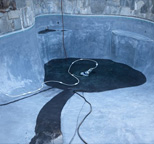
Winterizing an above-ground pool is a balancing act. You can’t completely empty it, or it may collapse. However, you do have to empty it so that the water line is below the return. In some ways, winterizing an above-ground pool is more challenging than winterizing an inground pool.
Not to worry though! This guide will walk you through the steps, so that you can winterize your above-ground pool with confidence that it will be ready for spring.
Step 1: Prepare the Water and Equipment
Before you close the pool, it is essential that you make sure the water is properly balanced and clean. Test your pool for everything you routinely test for, and make sure your chlorine and mineral salt levels are accurate. If they are not, you may want to pull out any equipment, stairs, etc., before you add shock. That way, you don’t have to wait too long to continue with the winterizing.
Step 2: Clean the Pool
To make sure that the pool is as clean as possible when you open it up in the spring, it’s wise to clean the pool now. Scrub away stains and vacuum up any dirt or debris. Take out and clean the filter skimmers and pump baskets.
Step 3: Add Winterizing Chemicals
Chlorine pools and mineral salt pools both need their own winterizing chemicals to keep the water healthy over the winter. Follow the instructions on your specific winterizing chemicals.
Need help winterizing your above-ground pool? Look no further! At Leisure Industries, our team is here to help! Contact us today!

Step 4: Drain Some of the Water
Drain the water so that it is comfortably below the return. This prevents water from freezing and damaging delicate internal parts of the pool over the winter. Some people choose to add skimmer guards and plug the return line instead, but we think draining the pool a bit is simpler and more failsafe. Whatever you do, do not drain the pool completely.
Step 5: Add the Air Pillow
In our climate, an air pillow is a great idea. You add one of these inflatable pillows just so that it will collapse when the water freezes. If the water freezes in a pool without an air pillow, then the ice may push outward on the pool and cause damage. With an air pillow, the pressure from the ice can go into the pillow instead.
Step 6: Add Your Cover
Like inground pools, above-ground pools also need covers for the winter. If you have pets or children, it’s wise to invest in a quality safety cover to prevent them from accessing the water or ice at all. You can use a water tube to secure the pool if you have a deck around it. Also, add a cover pump to drain water accumulation so that the cover isn’t damaged.
Want Professional Help Closing Your Pool?
As we start preparing for the cooler months, it is important to winterize your pool. To learn more, give our team at Leisure Industries a call today.




